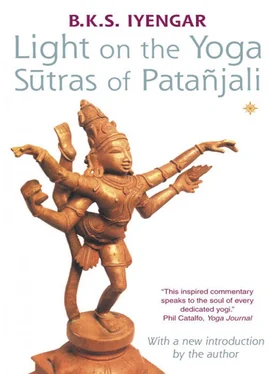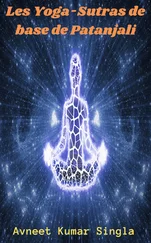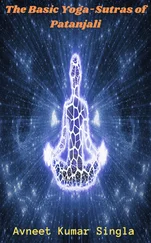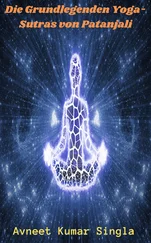1 ...6 7 8 10 11 12 ...20 AUM is known as pranava , or exalted praise of God. God is worshipped by repeating or chanting AUM, because sound vibration is the subtlest and highest expression of nature. Mahat belongs to this level. Even our innermost unspoken thoughts create waves of sound vibration, so AUM represents the elemental movement of sound, which is the foremost form of energy. AUM is therefore held to be the primordial way of worshipping God. At this exalted level of phenomenal evolution, fragmentation has not yet taken place. AUM offers complete praise, neither partial nor divided: none can be higher. Such prayer begets purity of mind in the sadhaka , and helps him to reach the goal of yoga. AUM, repeated with feeling and awareness of its meaning, overcomes obstacles to Self-Realization.
The obstacles to healthy life and Self-Realization are disease, indolence of body or mind, doubt or scepticism, carelessness, laziness, failing to avoid desires and their gratification, delusion and missing the point, not being able to concentrate on what is undertaken and to gain ground, and inability to maintain concentration and steadiness in practice once attained. They are further aggravated through sorrows, anxiety or frustration, unsteadiness of the body, and laboured or irregular breathing.
Ways of surmounting the obstacles and reaching the goal
The remedies which minimize or eradicate these obstacles are: adherence to single-minded effort in sadhana , friendliness and goodwill towards all creation, compassion, joy, indifference and non-attachment to both pleasure and pain, virtue and vice. These diffuse the mind evenly within and without and make it serene.
Patañjali also suggests the following methods to be adopted by various types of practitioners to diminish the fluctuations of the mind.
Retaining the breath after each exhalation (the study of inhalation teaches how the self gradually becomes attached to the body; the study of exhalation teaches non-attachment as the self recedes from the contact of the body; retention after exhalation educates one towards detachment); involving oneself in an interesting topic or object contemplating a luminous, effulgent and sorrowless light; treading the path followed by noble personalities; studying the nature of wakefulness, dream and sleep states, and maintaining a single state of awareness in all three; meditating on an object which is all-absorbing and conducive to a serene state of mind.
Any of these methods can be practised on its own. If all are practised together, the mind will diffuse evenly throughout the body, its abode, like the wind which moves and spreads in space. When they are judiciously, meticulously and religiously practised, passions are controlled and single-mindedness develops. The sadhaka becomes highly sensitive, as flawless and transparent as crystal. He realizes that the seer, the seeker and the instrument used to see or seek are nothing but himself, and he resolves all divisions within himself.
This clarity brings about harmony between his words and their meanings, and a new light of wisdom dawns. His memory of experiences steadies his mind, and this leads both memory and mind to dissolve in the cosmic intelligence.
This is one type of samadhi , known as sabija samadhi , with seed, or support. From this state, the sadhaka intensifies his sadhana to gain unalloyed wisdom, bliss and poise. This unalloyed wisdom is independent of anything heard, read or learned. The sadhaka does not allow himself to be halted in his progress, but seeks to experience a further state of being: the amanaskatva state.
If manolaya is a passive, almost negative, quiet state, amanaskatva is a positive, active state directly concerned with the inner being, without the influence of the mind. In this state, the sadhaka is perfectly detached from external things. Complete renunciation has taken place, and he lives in harmony with his inner being, allowing the seer to shine brilliantly in his own pristine glory.
This is true samadhi: seedless or nirbija samadhi.
Why did Patañjali begin the Yoga Sutras with a discussion of so advanced a subject as the subtle aspect of consciousness? We may surmise that intellectual standards and spiritual knowledge were then of a higher and more refined level than they are now, and that the inner quest was more accessible to his contemporaries than it is to us.
Today, the inner quest and the spiritual heights are difficult to attain through following Patañjali’s earlier expositions. We turn, therefore, to this chapter, in which he introduces kriyayoga , the yoga of action. Kriyayoga gives us the practical disciplines needed to scale the spiritual heights.
My own feeling is that the four padas of the Yoga Sutras describe different disciplines of practice, the qualities or aspects of which vary according to the development of intelligence and refinement of consciousness of each Sadhaka.
Sadhana is a discipline undertaken in the pursuit of a goal. Abhyasa is repeated practice performed with observation and reflection. Kriya , or action, also implies perfect execution with study and investigation. Therefore, sadhana, abhyasa , and kriya all mean one and the same thing. A sadhaka , or practitioner, is one who skilfully applies his mind and intelligence in practice towards a spiritual goal.
Whether out of compassion for the more intellectually backward people of his time, or else foreseeing the spiritual limitations of our time, Patañjali offers in this chapter a method of practice which begins with the organs of action and the senses of perception. Here, he gives those of average intellect the practical means to strive for knowledge, and to gather hope and confidence to begin yoga: the quest for Self-Realization. This chapter involves the sadhaka in the art of refining the body and senses, the visible layers of the soul, working inwards from the gross towards the subtle level.
Although Patañjali is held to have been a self-incarnated, immortal being, he must have voluntarily descended to the human level, submitted himself to the joys and sufferings, attachments and aversions, emotional imbalances and intellectual weaknesses of average individuals, and studied human nature from its nadir to its zenith. He guides us from our shortcomings towards emancipation through the devoted practice of yoga. This chapter, which may be happily followed for spiritual benefit by anyone, is his gift to humanity.
Kriyayoga , the yoga of action, has three tiers: tapas, svadhyaya and Isvara pranidhana. Tapas means burning desire to practise yoga and intense effort applied to practice. Svadhyaya has two aspects: the study of scriptures to gain sacred wisdom and knowledge of moral and spiritual values; and the study of one’s own self, from the body to the inner self. Isvara pranidhana is faith in God and surrender to God. This act of surrender teaches humility. When these three aspects of kriyayoga are followed with zeal and earnestness, life’s sufferings are overcome, and samadhi is experienced.
Sufferings or afflictions (Klesas)
Klesas (sufferings or afflictions) have five causes: ignorance, or lack of wisdom and understanding ( avidya ), pride or egoism ( asmita ), attachment ( raga ), aversion ( dvesa ), and fear of death and clinging to life (abhinivessa). The first two are intellectual defects, the next two emotional, and the last instinctual. They may be hidden, latent, attenuated or highly active.
Читать дальше












